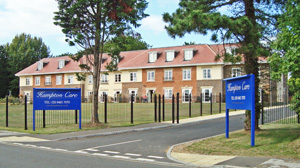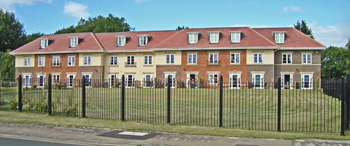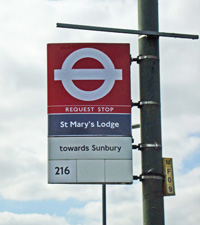St Mary's Hospital
Upper Sunbury Road, Hampton, Middlesex TW12 2DW
Medical
dates:
Medical
character:
General. Later, G.P.
In 1912 a local philanthropist,
Mr T. Foster Knowles of Riverdale, No. 1 Thames Street, donated the
funds for a cottage hospital. A one-acre plot of land in Upper
Sunbury Road was purchased for £550 and building work began in
September. The foundation stone was laid by the Revd. Prebendary
Digby Ram, vicar of St Mary's Parish Church.
The Hampton Cottage Hospital opened in June 1913. It had cost about £4,000 to build.
During WW1 (1914-1918) it became St Mary's Auxiliary Hospital. It had 20 beds and was affiliated to the Hounslow Military Hospital. At the beginning of the war, a number of wounded soldiers, including 13 Belgians, were admitted in October 1914. By August 1917 the number of beds had been doubled to 40. The nursing staff consisted of 4 trained nurses, assisted by the local St John's Voluntary Aid Detachment. The Hospital received a War Office grant of 3 shillings (15p) a day for each serviceman under its care.
After the war the Hospital was renamed St Mary's Cottage Hospital. It continued as a voluntary hospital, but as a cottage hospital it had no Resident Medical Officer and patients were treated by their own General Practitioners (G.P.s).
The Hospital was extended in 1923.
In 1939, at the outbreak of WW2, it joined the Emergency Medical Service.
In 1948 it joined the NHS under the control of the South West Middlesex Hospital Management Committee, part of the North West Metropolitan Regional Hospital Board. It had 24 beds (including 2 amenity wards with a bed each), an operating theatre, a bathroom and a W.C. However, there was only one sluice room with a jet for the whole Hospital. The nursing staff consisted of a Matron and 15 nurses.
In 1950 the wards and the nurses' bedrooms were redecorated. External redecoration was carried out the following year.
In 1958 the medical staff comprised 16 G.P.s and 6 visiting consultants.
In 1959 the visiting committee from the King's Fund found it a typical G.P. cottage hospital. It had no proper Out-Patients Department; clinics were held in a consulting room within the Hospital, while patients waited in the entrance hall. There were no changing cubicles, and no X-ray Department. The Physiotherapy Department had limited space and the waiting and changing arrangements were also not good.
In 1974, following a major reorganisation of the NHS, the Hospital came under the control of the Kingston and Richmond Area Health Authority, part of the South West Thames Regional Health Authority. It became a G.P. hospital with 26 beds.
In 1979, without any public consultation, the Area Health Authority announced that the Hospital would close temporarily for economic reasons. Local doctors, councillors, trades union members, the League of Friends and local residents rallied to the support of the Hospital and achieved a reprieve at the eleventh hour.
However, by 1985, the annual running cost of the Hospital was about £276,400, with the average daily cost of an in-patient £46.38.
By 1993 it had dropped the word 'Cottage' from its title. It had 12 G.P. beds and 6 geriatric beds.
In 1994, with the introduction of the marketplace system within the NHS, it joined the Kingston and District Community NHS Trust with 18 G.P. beds for Care of the Elderly.
The Hospital closed in 1999.
Present status (September 2009)
The Hampton Cottage Hospital opened in June 1913. It had cost about £4,000 to build.
During WW1 (1914-1918) it became St Mary's Auxiliary Hospital. It had 20 beds and was affiliated to the Hounslow Military Hospital. At the beginning of the war, a number of wounded soldiers, including 13 Belgians, were admitted in October 1914. By August 1917 the number of beds had been doubled to 40. The nursing staff consisted of 4 trained nurses, assisted by the local St John's Voluntary Aid Detachment. The Hospital received a War Office grant of 3 shillings (15p) a day for each serviceman under its care.
After the war the Hospital was renamed St Mary's Cottage Hospital. It continued as a voluntary hospital, but as a cottage hospital it had no Resident Medical Officer and patients were treated by their own General Practitioners (G.P.s).
The Hospital was extended in 1923.
In 1939, at the outbreak of WW2, it joined the Emergency Medical Service.
In 1948 it joined the NHS under the control of the South West Middlesex Hospital Management Committee, part of the North West Metropolitan Regional Hospital Board. It had 24 beds (including 2 amenity wards with a bed each), an operating theatre, a bathroom and a W.C. However, there was only one sluice room with a jet for the whole Hospital. The nursing staff consisted of a Matron and 15 nurses.
In 1950 the wards and the nurses' bedrooms were redecorated. External redecoration was carried out the following year.
In 1958 the medical staff comprised 16 G.P.s and 6 visiting consultants.
In 1959 the visiting committee from the King's Fund found it a typical G.P. cottage hospital. It had no proper Out-Patients Department; clinics were held in a consulting room within the Hospital, while patients waited in the entrance hall. There were no changing cubicles, and no X-ray Department. The Physiotherapy Department had limited space and the waiting and changing arrangements were also not good.
In 1974, following a major reorganisation of the NHS, the Hospital came under the control of the Kingston and Richmond Area Health Authority, part of the South West Thames Regional Health Authority. It became a G.P. hospital with 26 beds.
In 1979, without any public consultation, the Area Health Authority announced that the Hospital would close temporarily for economic reasons. Local doctors, councillors, trades union members, the League of Friends and local residents rallied to the support of the Hospital and achieved a reprieve at the eleventh hour.
However, by 1985, the annual running cost of the Hospital was about £276,400, with the average daily cost of an in-patient £46.38.
By 1993 it had dropped the word 'Cottage' from its title. It had 12 G.P. beds and 6 geriatric beds.
In 1994, with the introduction of the marketplace system within the NHS, it joined the Kingston and District Community NHS Trust with 18 G.P. beds for Care of the Elderly.
The Hospital closed in 1999.
Present status (September 2009)
The Hospital buildings became St Mary's Lodge, a care home for the elderly. This closed in 2004 and the buildings were demolished in 2006. A new care home - Hampton Care - was built on their site by Scammell Securities Ltd.

The driveway into Hampton Care.

Hampton Care.

St Mary's Lodge no longer exists, but its bus stop sign survives.
(Author unstated) 1917 List of the various hospitals treating military cases in the United Kingdom. London, H.M.S.O.
Sheaf J 1997 Cottage Hospital. In: Edwardian Hampton. The Story of Hampton and Hampton Hill from 1900-1914. Borough of Twickenham Local History Society 76, 13-14.
http://hansard.millbanksystems.com
http://hansard.millbanksystems.com
http://hansard.millbanksystems.com
http://hansard.millbanksystems.com
http://hansard.millbanksystems.com
http://site2.stjames-hamptonhill.org.uk
www.calmview.eu
www.geograph.org.uk
www.redcross.org.uk
www2.richmond.gov.uk
Return to home page